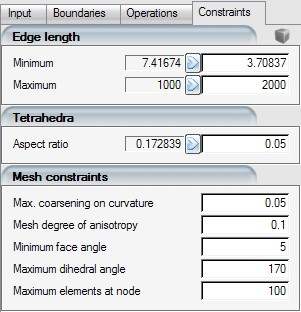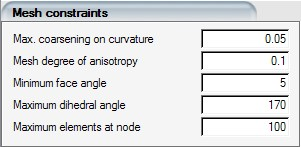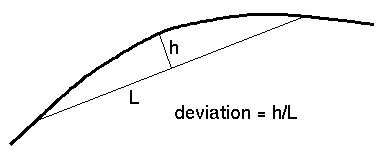

OptiGrid guarantees a mesh in which no newly created edges are smaller than the user-specified Minimum edge length. If there are edges smaller than this value, OptiGrid may or may not succeed in eliminating them completely.
Note: The edge length must be defined in the same units as in the original mesh file. Moreover, the prism/hexa layers height will not be affected by the minimum edge length if Y+ adaptation is enabled with Constant Height option.
OptiGrid also guarantees a mesh in which no newly created edges are larger than the user-specified Maximum edge length. The edge length must be defined in the same units as in the original mesh file.
To help define both lengths, the actual minimum and maximum edge lengths of the initial grid are shown by the graphical interface. To use the actual edge length, click the left arrow.

OptiGrid guarantees a mesh in which no newly created tetras have an aspect ratio smaller than the user-specified Aspect ratio. However, if some tetras in the original mesh violate the aspect ratio constraint, OptiGrid may or may not be able to cure these elements.
In 2D, the aspect ratio is the ratio of the radius of the circle inscribed within the triangular element, compared to the radius of the smallest circle containing the element. In 3D, these circles are replaced by spheres.
To attain the most anisotropic mesh, you should use an aspect ratio value up to 10-2, depending on the ability of the flow solver to accept stretched meshes. For finite volume codes, such as Fluent, the aspect ratio should not be smaller than 0.1 if computing a viscous solution.

OptiGrid guarantees a mesh in which no prisms have an aspect ratio smaller than Aspect ratio. Prisms which violate this constraint in the original mesh may not all be repaired.
The prism aspect ratio is defined as a function of the aspect ratio of its two triangular faces and the minimum/maximum ratio of the determinant of the Jacobian.
Important: Limiting the prism aspect ratio too severely (for example, setting a minimum prism aspect ratio that is too high) will adversely affect Y+ adaptation.
Warpage is the cosine of the angle between the normal vectors of the two triangles obtained by cutting any quadrangular face of the prism in half. The warpage ranges from 0 to 1. A value of 1 yields straight prisms, while a value of 0 will result in skewed prisms. If the flow solver accepts highly skewed cells, a value of 0.1 is preferred, so that OptiGrid may perform to its full potential.
Tip: For Y+ adaptation, set the minimum warpage to 0.1 to
give OptiGrid full freedom to adjust the prism layers. At convergence, the axial
edges of the prisms will be normal to the wall, giving a warpage near
1.0.

OptiGrid uses the determinant of the Jacobian to calculate the hexahedral determinant. Determinant ranges from 0 to 1, a value of 1 giving a perfect quality and a value of 0 giving a totally skewed hexahedral.
Warpage is the cosine of the angle (scaled from 0 to 1) between the normal vectors of the two triangular facets that form each face of a hexahedral element. A value of 1 yields hexas with perfectly flat faces, while a value of 0 will result in hexas with creased faces. If the flow solver accepts skewed cells, a value of 0.5 is preferred, so that OptiGrid may perform to its full potential.

Max. coarsening on curvature is used to control the fineness of the mesh on curved surfaces so as to preserve the integrity of the CAD geometry. It prevents over-coarsening of the mesh on high-curvature surfaces and causes refinement if the deviation from curved surfaces in the original mesh is too large.
The level of coarsening on curvature for a boundary edge is defined as the ratio of the distance between the mid-point of the edge and the nearest surface, divided by the length of the edge (see Figure 12.2: Coarsening on Curvature for a Boundary Edge). The coarsening should be set to a few percentage points, more or less.
The Mesh degree of anisotropy is an overall aspect ratio for the mesh. It should be larger than the values of the quality metrics for the individual cell types.
The Minimum face angle is the minimum angle, in degrees, between two edges of a given quadrangular face (for hexahedral, prism and pyramid elements).
The Maximum dihedral angle is the maximum angle, in degrees, between two adjacent faces of an element.
The Maximum number of elements at node sets the maximum number of elements that may be connected at a node.



